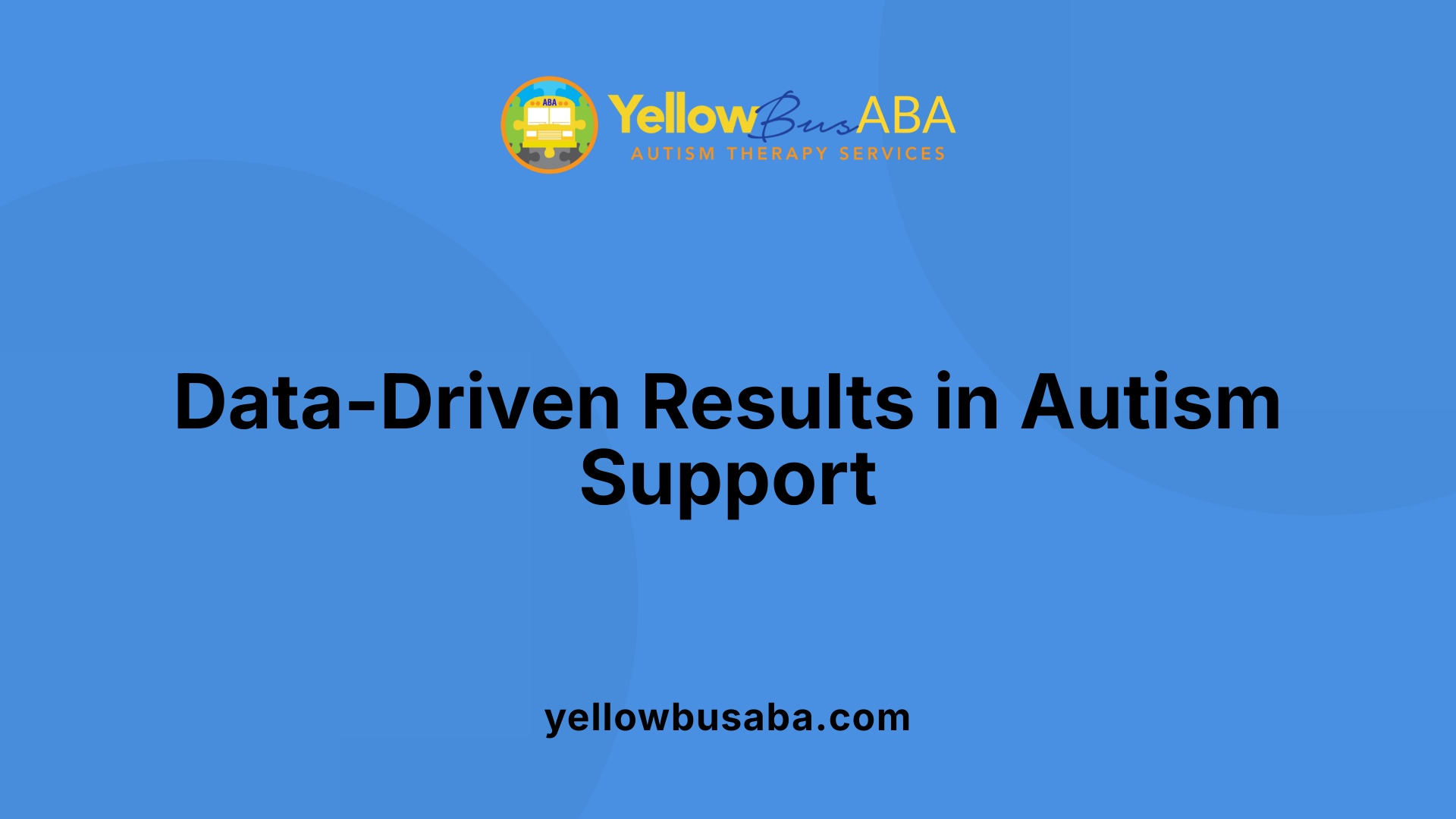From Structure to Confidence: The ABA Effect
November 14, 2025
Transforming Lives Through Science: How ABA Therapy Builds Confidence and Skills

Unlocking Potential with ABA Therapy
Applied Behavior Analysis (ABA) therapy has long been a cornerstone in autism treatment, offering structured, evidence-based interventions that transform behaviors and foster independence. This article explores the far-reaching effects of ABA, demonstrating how a systematic approach to learning enhances confidence and life skills for individuals with autism spectrum disorder (ASD).
Understanding ABA Therapy: A Science-Driven Approach

What is Applied Behavior Analysis (ABA) therapy?
Applied Behavior Analysis (ABA) therapy is a scientifically supported approach aimed at improving specific behaviors, especially in children with autism spectrum disorder (ASD). It focuses on enhancing helpful behaviors such as communication, social skills, attention, and academics while reducing harmful or interfering behaviors.
What is the science base of ABA?
ABA is grounded in the science of learning and behavior, relying on well-established principles of how behaviors are acquired and maintained. Since its development in the 1960s, ABA has been extensively studied and recognized as an evidence-based best practice by the US Surgeon General and the American Psychological Association.
How does the A-B-C model work in ABA?
Central to ABA therapy is the A-B-C model, which stands for Antecedent, Behavior, and Consequence. Therapists observe what happens before a behavior (antecedent), the behavior itself, and the result or response that follows (consequence). Understanding this sequence helps identify why a behavior occurs and how to modify it effectively.
Why are ABA programs individualized?
Each ABA program is customized to fit the unique needs of the individual. Qualified professionals called Board Certified Behavior Analysts (BCBAs) assess skills, preferences, and challenges to design tailored treatment plans. These focus on developing areas like communication, social skills, self-care, play, motor abilities, and academics.
What role does positive reinforcement play in ABA?
Positive reinforcement is a core strategy in ABA therapy. It involves rewarding desired behaviors to encourage their recurrence. For example, a child might receive praise, tokens, or preferred activities following a positive action. This approach encourages learning and strengthens adaptive behaviors over time.
The Historical Evolution of ABA Therapy

How has ABA therapy developed since the 1960s?
Applied Behavior Analysis (ABA) therapy has its roots in the science of learning and behavior, with foundational research beginning in the early 1960s. Since then, ABA has evolved into a systematic approach aimed at increasing helpful behaviors while reducing harmful or interfering ones. Over the decades, the therapy has grown from experimental applications into a structured intervention model that is extensively customized to individual needs, especially for children with Autism Spectrum Disorder (ASD).
How has the scientific evidence supporting ABA therapy grown?
Scientific evidence for ABA therapy has expanded significantly since its inception. Numerous studies and meta-analyses have consistently demonstrated its effectiveness in enhancing intellectual functioning, communication skills, socialization, and daily living abilities in individuals with developmental challenges. Research employing controlled experimental designs, including quasi-experimental studies using validated assessment tools like the Kindergarten Inventory of Social/Emotional Tendencies (KIST), confirm that ABA leads to meaningful improvements in adaptive behaviors and reduces symptoms such as separation anxiety.
How is ABA recognized by leading health organizations?
Given the strong and growing body of evidence, ABA therapy has attained recognition as an evidence-based best practice by prominent health authorities, including the US Surgeon General and the American Psychological Association. These endorsements underscore ABA's status as a scientifically validated treatment modality for autism and related developmental conditions. This recognition has also facilitated wider insurance coverage and integration into standard care protocols worldwide, reflecting its broad acceptance and proven effectiveness.
Core Techniques Driving ABA Success

What techniques are used in ABA therapy?
ABA therapy employs a comprehensive range of evidence-based techniques designed to foster meaningful behavioral change and skill acquisition.
Positive Reinforcement
One of the fundamental strategies in ABA is positive reinforcement, which involves rewarding desired behaviors to increase their frequency. This encourages individuals to repeat helpful actions and skills.
Prompting and Fading
Prompting is used to guide a learner toward the correct response or behavior. As the individual becomes more proficient, prompts are gradually faded out to promote independence.
Discrete Trial Training (DTT)
DTT breaks down skills into small, structured components, teaching them one step at a time through repeated practice. This method is particularly effective for teaching communication and academic skills.
Natural Environment Teaching (NET)
NET occurs in everyday settings, utilizing natural reinforcers and situations to teach skills in real-life contexts. This fosters generalization and functional use of learned behaviors.
Behavior Chaining and Modeling
Complex behaviors are taught using behavior chaining, where actions are linked into a sequence, and modeling, where the therapist demonstrates behaviors for the learner to imitate.
Communication Support Techniques
To support language and social skills, ABA incorporates communication-focused interventions such as Functional Communication Training (FCT), Picture Exchange Communication System (PECS), and script fading. These tools help improve expressive and receptive language abilities.
ABA interventions are systematically designed based on assessments applying the ABC (Antecedent-Behavior-Consequence) model to understand behavior triggers and outcomes. The use of these varied techniques enables tailored interventions that address individual needs efficiently and effectively.
Measurable Benefits of ABA for Individuals with Autism

How does ABA therapy benefit individuals with autism?
ABA therapy delivers targeted, individualized support that improves various essential skills in children with autism. Through carefully designed programs led by Board Certified Behavior Analysts (BCBAs), ABA enhances communication, social abilities, attention, and academic performance, adapting strategies to meet each child’s unique needs.
Improvements in language and communication
ABA uses methods like positive reinforcement and prompting to encourage expressive and receptive language development. Research shows significant gains in communication skills, with effect sizes indicating strong improvements in both expressive (g=0.742) and receptive language (g=0.597) abilities.
Enhanced social skills and socialization
ABA interventions lead to better social interaction and emotional regulation. Studies demonstrate notable progress in socialization (g=0.444) and reductions in social anxiety, enabling children to engage more comfortably with peers and adults in diverse settings.
Advances in attention, focus, and academics
By reinforcing attention and appropriate behaviors, ABA fosters greater focus and learning readiness. Children receiving intensive ABA therapy show improvements in academic-related skills and cognitive functions, contributing to higher intellectual functioning overall.
Impact on daily living and self-care skills
ABA supports gains in daily living areas such as self-care, motor skills, and play. Although improvements in daily living skills show more modest effects (g=0.138), consistent intervention helps children develop independence and better manage everyday tasks.
Research-based evidence supporting benefits
ABA is an evidence-based treatment widely endorsed by authorities, including the US Surgeon General and the American Psychological Association. Meta-analyses confirm its effectiveness across countries and settings, showing consistent positive results in intellectual functioning, language, social skills, and adaptive behavior.
Together, these benefits illustrate how ABA therapy is a powerful, research-supported tool that enhances quality of life and functional abilities for individuals with autism when delivered with intensity and fidelity over time.
Early and Intensive Intervention: Maximizing Outcomes with ABA

Why is Early Start Crucial in ABA Therapy?
ABA therapy is most effective when begun early, specifically within the first few years of a child's life. Starting early allows for large developmental gains that can substantially improve the child's future abilities in communication, socialization, and daily skills. This early intervention taps into the child's critical learning periods, setting a strong foundation for growth.
What Is the Recommended Intensity and Duration of ABA?
Research supports intensive, long-term ABA therapy for optimal results. Typically, this involves 25 to 40 hours per week over 1 to 3 years. Such thorough engagement ensures consistent skill development and behavioral improvements. Intensive therapy allows personalized goals to be continually targeted and adjusted according to progress.
What Are the Long-Term Developmental Gains?
Children undergoing early and intensive ABA show meaningful improvements in intellectual functioning, language development, and social skills. These gains enhance adaptive behaviors, enabling children to navigate daily life and social interactions more effectively. Moreover, ABA's structured approach has been scientifically validated to promote positive outcomes in communication and behavior.
How Does Early ABA Reduce Future Special Service Needs?
By delivering substantial early developmental improvements, ABA therapy can decrease the need for extensive special education or support services later. Children develop greater independence through enhanced communication and self-care skills, leading to more positive educational and social experiences.
How does ABA therapy benefit individuals with autism?
Early implementation of ABA (more than 20 hours a week during the first few years of life) can produce large gains in development and reduce the need for special services later in life.
| Aspect | Details | Explanation |
|---|---|---|
| Early Start | Within first few years | Leverages critical learning periods |
| Therapy Intensity | 25-40 hours/week | Supports sustained behavior and skill development |
| Duration | 1-3 years | Allows comprehensive, individualized intervention |
| Developmental Gains | Improved IQ, language, social skills | Enhances adaptive behavior and communication |
| Reduced Future Support Needs | Decreased reliance on special education and interventions | Promotes independence and better life outcomes |
Personalization at the Core: Designing Effective ABA Programs
Role of Board Certified Behavior Analysts (BCBAs)
ABA therapy services are provided by qualified professionals, primarily Board Certified Behavior Analysts (BCBAs). These experts conduct initial assessments and design customized behavior programs tailored to each individual's needs and abilities. BCBAs oversee treatment plans and ensure interventions align with the latest research and best practices.
Assessment-Driven Goal Setting
ABA programs begin with thorough evaluations that identify a child's current skills and challenges. Based on these assessments, personalized goals are developed to foster improvements in communication, social skills, self-care, play, motor abilities, and academic achievement. This data-driven approach ensures each child receives targeted and effective therapy.
Tailoring Interventions Based on Skills and Preferences
Interventions are carefully adapted to match the child's unique preferences and learning style. Techniques such as positive reinforcement, prompting, and structured sessions like Discrete Trial Training (DTT) or the Early Start Denver Model (ESDM) are selected to optimize outcomes. The therapy focuses on increasing helpful behaviors while reducing interfering ones, improving overall functioning.
Parent Involvement and Education
Family participation is vital in ABA therapy. Parents receive guidance and training to support their child's progress at home, reinforcing skills practiced during sessions. Educating caregivers fosters consistent intervention across settings and enhances generalization of skills to everyday life.
Who provides ABA therapy services?
ABA therapy services are delivered by trained professionals including BCBAs, therapists, and technicians skilled in behavioral analysis. Providers often offer varied service settings such as center-based, home-based, community, virtual, and school placements, facilitating flexible access. Collaborative work with caregivers ensures personalized treatment and early intervention benefits. Many providers accept insurance plans and are accredited to support families' needs effectively.
Evidence-Based Validation: Research & Meta-Analyses Supporting ABA
Scientific Studies on ABA Effectiveness
Numerous scientific studies have demonstrated that Applied Behavior Analysis (ABA) significantly improves socialization, communication, and expressive language skills in children with autism spectrum disorder (ASD). Research indicates that structured and individualized ABA programs lead to meaningful gains across multiple developmental domains.
Meta-Analyses Results on IQ, Communication, Adaptive Behavior
Meta-analyses combining data from diverse studies reveal strong positive effects of ABA therapy on intellectual abilities, communication skills, and adaptive behaviors. For example, mean effect sizes indicate moderate to large improvements in IQ (g=0.740), expressive language (g=0.742), receptive language (g=0.597), and overall adaptive behavior (g=0.422). Communication (g=0.650) and socialization (g=0.444) show especially notable gains.
Effect Sizes and Statistical Significance
These effect sizes reflect statistically significant advancements, confirming ABA's robust impact on developmental outcomes. Gains in daily living skills, while smaller (g=0.138), nonetheless contribute to functional independence. The consistency of results across studies underscores ABA's reliability and clinical relevance.
International and Cross-Setting Applicability
Studies analyzed were conducted globally and within various institutional and home settings, demonstrating ABA’s broad applicability. This widespread validation supports its classification as an evidence-based best practice treatment recommended by medical authorities such as the U.S. Surgeon General and the American Psychological Association.
| Area of Improvement | Effect Size (g) | Description |
|---|---|---|
| Intellectual Abilities | 0.740 | Large gains in IQ and cognitive functioning |
| Expressive Language | 0.742 | Significant improvements in speaking skills |
| Receptive Language | 0.597 | Enhanced understanding and language receipt |
| Adaptive Behavior | 0.422 | Moderate gains in day-to-day functional skills |
| Communication | 0.650 | Strong improvements in communication ability |
| Socialization | 0.444 | Improved social interaction capabilities |
| Daily Living Skills | 0.138 | Smaller yet meaningful progress in self-care |
How ABA Therapy Is Delivered Across Diverse Settings
Home-based ABA
ABA therapy often takes place in the child's home, a comfortable and familiar environment. This setting allows therapists to work one-on-one with the child and family, focusing on daily living skills, communication, and behavior in real-life contexts. Home-based programs are highly individualized and aim to create routines that caregivers can support and maintain.
School-based Services
Schools provide an important environment for ABA interventions, integrating therapy with academic learning and socialization opportunities. ABA programs in schools help children develop skills necessary for classroom success, such as attention, focus, and peer interaction. Collaborations between teachers and ABA therapists ensure consistent reinforcement and generalization of skills learned.
Community and Center-based Programs
Community and center-based ABA programs offer structured settings where children participate in social groups, play, and skills training under professional supervision. These centers provide access to specialized resources and peer interactions while maintaining individualized goals. For some children, intensive therapy delivered in these settings can be more effective due to the controlled learning environment and availability of multiple therapists.
Virtual ABA Options
With advances in technology, virtual ABA therapy has emerged as a valuable option, especially when in-person sessions are not feasible. Online platforms allow therapists to coach caregivers remotely and directly engage with the child, employing many core ABA techniques. Virtual delivery can expand access to services while maintaining program consistency and effectiveness.
Who Provides ABA Therapy Services?
ABA therapy services are delivered by skilled and certified professionals, notably Board Certified Behavior Analysts (BCBAs), therapists, and technicians trained in behavioral analysis and autism interventions. Organizations like BlueSprig provide a spectrum of ABA therapy settings—from home and school to community centers and virtual platforms—tailoring services to each child's unique needs. Providers collaborate closely with families to develop individualized treatment plans, ensuring comprehensive and consistent care. Many reputable providers are accredited and accept insurance, making quality ABA therapy accessible to more families.
Insurance and Accessibility: Making ABA Therapy Attainable
Insurance Coverage and Medicaid
ABA therapy is recognized as a medically necessary treatment, which means many insurance plans, including Medicaid, provide coverage for these services. This ensures that families can access intensive and long-term ABA therapy without prohibitive out-of-pocket costs. Coverage often includes 25 to 40 hours of therapy per week, especially when prescribed for children with autism spectrum disorder (ASD).
Steps to Access ABA Services
The process to begin ABA therapy starts with consulting a medical provider who can diagnose and recommend ABA. Next, families should review their insurance policies to understand what ABA services are covered and what requirements must be met. Following this, selecting a qualified provider, such as a Board Certified Behavior Analyst (BCBA), is crucial for developing an individualized treatment plan tailored to the child's needs.
Evaluating ABA Providers Through Meaningful Questions
Choosing the right ABA provider involves asking important questions about staff qualifications, including certifications and experience. It is essential to understand the provider's safety protocols and treatment methodologies, ensuring they use evidence-based approaches aligned with the principles of ABA. Additionally, inquire about how progress is evaluated and how frequently updates are provided to ensure the therapy is effective and goals are being met.
Challenges and Solutions in Accessing Therapy
Despite insurance coverage, accessing ABA therapy can pose challenges such as limited availability of qualified providers and waiting lists. Families may face administrative hurdles during insurance approval or face gaps in services. To overcome these, families can seek support through advocacy groups, verify insurance requirements early, and consider telehealth ABA options where available. Early intervention and persistence in navigating the system increase the chances of timely and effective therapy access.
Building Communication: ABA’s Role in Language Development

How does ABA therapy benefit communication improvements?
ABA therapy plays a critical role in enhancing communication skills for individuals with autism. By using personalized, evidence-based approaches, ABA helps develop both receptive (understanding) and expressive (speaking) language abilities. These improvements are instrumental for effective social interaction and adaptive functioning.
What expressive and receptive language gains are observed?
Research shows substantial gains in expressive language, with effect sizes measuring around 0.742, and receptive language at about 0.597. These improvements enable individuals with autism to not only understand but also clearly express their needs and feelings, which supports better relationships and increased independence.
How are techniques like Functional Communication Training (FCT) and the Picture Exchange Communication System (PECS) used?
ABA incorporates specialized communication techniques such as Functional Communication Training (FCT) and the Picture Exchange Communication System (PECS). FCT teaches alternative communication methods to replace challenging behaviors, while PECS uses pictures to help individuals initiate communication. Both methods reinforce positive communication behavior through consistent rewards, encouraging use in daily life.
How does enhancing communication improve social interactions?
Improved communication skills gained through ABA therapy directly boost social interactions. Enhanced ability to express and understand language helps individuals engage more meaningfully with peers and family, reducing frustration and social withdrawal. Increased communication competence also supports better participation in group activities and learning environments.
These focused communication interventions within ABA demonstrate its power to transform social and adaptive outcomes for children with autism, making everyday interactions more successful and rewarding.
Promoting Social Skills and Adaptive Behavior Through ABA

How Does ABA Improve Socialization in Children with ASD?
ABA therapy significantly enhances social skills among children with autism spectrum disorder (ASD). Through structured and individualized interventions, children learn positive social interactions and communication techniques. Studies consistently report moderate improvements, with an effect size of 0.444 indicating meaningful growth in children’s ability to engage and socialize effectively.
In What Ways Does ABA Support Adaptive Behavior Development?
Adaptive behavior, referring to practical daily life skills, is another area where ABA shows positive results. ABA helps children develop abilities such as self-care, play, and motor skills that contribute to independence. Although improvements in overall adaptive behavior are moderate (effect size of 0.422), gains in daily living skills are generally smaller (effect size of 0.138), highlighting an area where ongoing focus is beneficial.
What Does Research Say About the Effect Sizes of These Improvements?
Meta-analyses of multiple studies underline the effectiveness of ABA on socialization and adaptive behavior. With socialization marked by a moderate effect size (g=0.444) and adaptive behaviors showing a moderate overall effect (g=0.422), the data confirms ABA’s role in facilitating important functional skills. Communication skills also display significant enhancement (g=0.650), reinforcing ABA's comprehensive influence on developmental domains.
How Does Parent Education Influence Social Skill Generalization?
ABA programs often include parent education services to promote the generalization of social skills beyond therapy sessions. Training parents to implement ABA strategies helps children apply learned behaviors in natural settings, improving long-term outcomes. Involving families ensures consistency and reinforcement, which are crucial for sustaining social and adaptive behavior improvements.
ABA’s systematic and individualized approach, combined with empirical evidence, establishes it as a highly effective therapy for improving social and adaptive functions among children with ASD.
Addressing Challenging Behaviors with ABA

How does ABA approach reducing challenging behaviors?
ABA therapy focuses on increasing helpful behaviors while decreasing harmful or interfering ones. This is achieved through behavior reduction strategies that are carefully tailored to the individual's needs, often identified by a qualified behavior analyst (BCBA) through assessments.
What role do functional behavior assessments (FBA) play?
FBAs are essential for understanding why challenging behaviors occur. These assessments analyze the antecedents (what happens before), behaviors themselves, and consequences (what happens after) using the A-B-C model. By discovering the function of a behavior, ABA professionals can design targeted interventions that address its underlying cause rather than just the symptoms.
How are extinction and differential reinforcement used?
Two common techniques in ABA for behavior reduction are extinction and differential reinforcement. Extinction involves withholding reinforcement that previously maintained a problematic behavior, leading to its reduction over time. Differential reinforcement means reinforcing alternative, more appropriate behaviors while ignoring or not reinforcing the challenging behavior. Both strategies help shift behavior patterns toward more positive and functional actions.
How does reducing interfering behaviors improve daily functioning?
By minimizing behaviors that interfere with learning and social interaction, ABA therapy enhances skills like communication, focus, and socialization. This creates a foundation for greater independence in daily activities. Reducing challenging behaviors supports progress in communication, self-care, play, and academics, ultimately improving overall quality of life.
Table: Behavior Reduction Strategies in ABA
| Strategy | Description | Purpose |
|---|---|---|
| Functional Behavior Assessment (FBA) | Identifies reasons behind behaviors | Informs precise intervention planning |
| Extinction | Stops reinforcing unwanted behavior | Decreases frequency of problematic behavior |
| Differential Reinforcement | Rewards positive alternative behaviors | Encourages desirable behavior adoption |
These evidence-based strategies illustrate how ABA uses scientific principles to manage and reduce challenging behaviors effectively.
Parent and Caregiver Roles in ABA Therapy Success

Parent education services
Parents and caregivers play an essential role in ABA therapy by participating in education services designed to help them understand behavioral techniques. Through training sessions, they learn how to implement strategies such as positive reinforcement, prompting, and the A-B-C model at home.
Supporting consistency and generalization
By applying ABA principles consistently across home and community settings, parents help children generalize new skills beyond therapy sessions. This consistent support is vital to maintaining gains and encouraging the use of communication, social, and daily living skills in real-life situations.
Collaborative treatment planning
Caregivers work closely with Board Certified Behavior Analysts (BCBAs) during the assessment and treatment planning process. Their input helps tailor the ABA program to the child's unique preferences and needs, ensuring goals are achievable and meaningful.
Empowering families
ABA therapy empowers families by providing tools and knowledge to manage challenging behaviors and promote positive development. Through ongoing collaboration and support, parents become active partners in their child’s progress, contributing significantly to long-term success.
Quantifying Progress: Evaluation and Measurement in ABA

Use of assessment tools
ABA therapy relies heavily on validated assessment tools to measure initial skill levels and track progress. For example, tools like the Kindergarten Inventory of Social/Emotional Tendencies (KIST) are used to quantify social and emotional behaviors. Early and ongoing assessments are conducted by qualified professionals, typically Board Certified Behavior Analysts (BCBAs), who design individualized treatment plans based on these evaluations.
Data-driven decision making
ABA programs emphasize systematic data collection on behaviors during therapy sessions. Practitioners use this data to make informed decisions about treatment effectiveness. Quantitative measurements of behaviors allow therapists to objectively evaluate whether interventions are leading to improvements in targeted areas such as communication, social skills, and daily living activities.
Evaluating skill improvements and behavioral changes
Progress is measured across multiple domains including intellectual functioning, language development, socialization, and adaptive behaviors. The use of effect sizes in meta-analyses (e.g., g=0.740 for intellectual abilities, g=0.650 for communication) highlights the measurable benefits of ABA. Behavioral improvements are documented through increases in positive actions and decreases in interfering behaviors following the principles of reinforcement and the A-B-C model.
Monitoring and adjusting treatment plans
ABA therapy is highly individualized, necessitating continuous monitoring to tailor programs effectively. Regular reviews of assessment data allow BCBAs to adjust goals and strategies to better suit evolving needs. This dynamic approach ensures that therapy remains aligned with the child's progress and preferences, maximizing therapeutic gains over time.
The Future of ABA: Innovations and Broader Applications

Emerging Methodologies Within ABA
The field of Applied Behavior Analysis continuously evolves with innovative techniques enhancing traditional approaches like Discrete Trial Training (DTT), Pivotal Response Treatment (PRT), and the Early Start Denver Model (ESDM). These emerging methods focus on integrating technology, personalized interventions, and data-driven decision-making to fine-tune each individual's therapy. Innovations include telehealth delivery and virtual reality environments that simulate real-life social situations, enabling more accessible and engaging therapy sessions.
Expansion Into Community and Hybrid Models
ABA therapy is moving beyond clinical and institutional settings into community-based and hybrid models. This shift allows therapy to seamlessly integrate into everyday environments such as schools, homes, and social settings. Hybrid models combine in-person and remote sessions, providing flexibility and broader reach especially important in underserved areas. Community involvement fosters naturalistic learning and generalization of skills, enhancing overall outcomes.
Potential Applications Beyond Autism
While ABA is historically associated with Autism Spectrum Disorder, its principles hold promise for broader applications. Research is expanding into areas including developmental disabilities other than autism, behavioral challenges in elderly populations, and even mental health conditions such as anxiety and PTSD. The systematic approach of ABA to modify behaviors and teach new skills can benefit diverse groups, potentially improving quality of life across the lifespan.
Trends in Research and Clinical Practice
Current research trends emphasize the use of evidence-based, individualized programs with rigorous outcome measures. Studies increasingly highlight early intervention with intensive hours correlated to larger developmental gains. Additionally, collaborative efforts between behavior analysts, educators, and families aim to create holistic treatment plans. The integration of technology for assessment and monitoring progress is accelerating, ensuring data accuracy and responsiveness in therapy adjustments.
These promising advancements suggest that ABA will continue to broaden its impact, innovate methodologies, and adapt to varied clinical and community needs, solidifying its role as a comprehensive therapeutic approach.
From Structure to Confidence: Lasting Impact of ABA Therapy
ABA therapy stands as a beacon of hope and tangible progress for individuals with autism spectrum disorder, translating structured behavioral science into real-world confidence and independence. Grounded in evidence and shaped by personalized care, ABA fosters meaningful improvements across communication, social skills, and daily functioning. As access expands and research advances, the ABA effect continues to transform lives—building foundations not just for skill development but for lifelong growth and self-assurance.
References
- Applied Behavior Analysis (ABA)
- The effectiveness of applied behavior analysis program ...
- The effectiveness of applied behavior analytic interventions ...
- Applied Behavior Analysis (ABA)
- Applied Behavior Analysis (ABA)
- Applied Behavior Analysis (ABA)
- 6 Benefits of ABA Therapy for Children with Autism
- Applied Behavior Analysis (ABA)

.avif)
.jpg)



